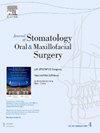Difference in survival and prognosis between malignant tumors of odontogenic origin
IF 1.8
3区 医学
Q2 DENTISTRY, ORAL SURGERY & MEDICINE
Journal of Stomatology Oral and Maxillofacial Surgery
Pub Date : 2024-11-28
DOI:10.1016/j.jormas.2024.102179
引用次数: 0
Abstract
Introduction
The prognosis of metastatic ameloblastoma (METAM), now defined as a benign tumor, and malignant odontogenic tumors (MOT) is poorly studied in the literature. The aim of this study was to determine the prognosis and factors influencing the survival of these patients.
Material and methods
Using the SEER database, we retrieved clinical data of patients with malignant tumors of dental origin between 1975 and 2020. They include 3 histological groups: metastatic ameloblastoma (METAM), malignant odontogenic tumors (MOT, including odontogenic carcinoma, odontogenic sarcoma, primary intraosseous carcinoma, and ameloblastic carcinoma) and ameloblastic fibrosarcoma (AFS).
Results
On 251 patients, we observed no significant difference in disease-specific survival (DSS) between the three histological groups, with 5-year DSS of 77.4 % (59.9 – 100), 84.0 % (78.7 – 89.7) and 71.1 % (50.7 – 99.7) for METAM, MOT and AFS respectively (p = 0.460). In the MOT group, using a multivariate analysis, surgical treatment appeared to be a protective factor for DSS (HR = 0.483 [0.243 - 0.960], p = 0.038) after taking into account the potential confounding factors mentioned above. No variable significantly influenced DSS in the METAM and AFS group in univariate analysis.
Discussion
We found no difference in specific survival between the three histological groups. Although metastatic ameloblastoma was reclassified as a benign tumor by the WHO in 2017, the vital risk for patients remains consequent, and statistically similar to malignant odontogenic tumors.
牙源性恶性肿瘤的生存和预后差异。
转移性成釉细胞瘤(METAM)目前被定义为良性肿瘤,而恶性牙源性肿瘤(MOT)的预后在文献中研究较少。本研究的目的是确定这些患者的预后和影响生存的因素。材料与方法:使用SEER数据库检索1975 - 2020年间牙齿源性恶性肿瘤患者的临床资料。它们包括3组组织学:转移性成釉细胞瘤(METAM)、牙源性恶性肿瘤(MOT,包括牙源性癌、牙源性肉瘤、原发性骨内癌和成釉细胞癌)和成釉纤维肉瘤(AFS)。结果:251例患者中,三个组织学组间的疾病特异性生存(DSS)无显著差异,METAM、MOT和AFS的5年DSS分别为77.4%(59.9 ~ 100)、84.0%(78.7 ~ 89.7)和71.1% (50.7 ~ 99.7)(p = 0.460)。在MOT组中,通过多因素分析,考虑到上述潜在的混杂因素,手术治疗似乎是DSS的保护因素(HR = 0.483 [0.243 - 0.960],p = 0.038)。在单因素分析中,METAM和AFS组无显著影响DSS的变量。讨论:我们发现三个组织学组的具体生存率没有差异。尽管转移性成釉细胞瘤在2017年被世界卫生组织重新归类为良性肿瘤,但患者的生命风险仍然是随之而来的,在统计上与恶性牙源性肿瘤相似。
本文章由计算机程序翻译,如有差异,请以英文原文为准。
求助全文
约1分钟内获得全文
求助全文
来源期刊

Journal of Stomatology Oral and Maxillofacial Surgery
Surgery, Dentistry, Oral Surgery and Medicine, Otorhinolaryngology and Facial Plastic Surgery
CiteScore
2.30
自引率
9.10%
发文量
0
审稿时长
23 days
 求助内容:
求助内容: 应助结果提醒方式:
应助结果提醒方式:


